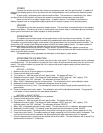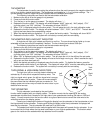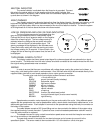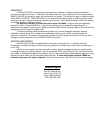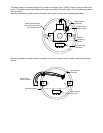POWER
Connect the red wire from the main harness to accessory power from the ignition switch. In addition to
powering the display system, this is also where the low voltage detection circuit monitors the electrical system
voltage.
A good quality, solid state ignition switch should be used. The contacts on a mechanical “bar” switch
can bounce due to the vibration and cause the system to momentarily loose power and reset itself.
Never connect this to a battery charger alone. It needs to have a 12 volt battery connected to it.
Battery chargers have an unregulated voltage output that will cause the system to not operate properly.
GROUND
The black wire is the main ground for display system. This should be connected directly to the negative
cable on the battery. Connecting to a tank or frame ground can cause a weak or intermittent ground connection.
A poor ground connection can cause improper or erratic operation.
SPEEDOMETER
The speed input connector plugs into the speed sensor to tell how fast you are traveling. On cable
driven applications, the external sensor connects to the speedometer cable and provides the electric signal.
The sensor is normally bolted directly to the bottom of the speedometer, but can also be remote mounted. The
sensor has a 5/8” course thread fitting that accepts mid-80’s and earlier cables directly. For newer cycles the
speedometer cable will need to be replaced with one having the correct fitting.
With transmissions having the built-in electric sensor, a three-wire harness adapter connects the
transmission speed sensor to the speedometer. This system will also accept most after-market inductive, Hall-
effect, or ground switch sensors.
The speedometer is fully adjustable and calibration is discussed in a later section.
SPEEDOMETER CALIBRATION
The speedometer calibration is done using the function (trip) switch. The speedometer can be calibrated
two different ways. The first method is to place the unit in auto-cal mode and drive exactly one mile (one km for
metric). The second method is to place the unit in adjust mode and the speed reading can be moved up or
down while driving.
METHOD 1, AUTOCAL
1. Make sure the key is off so the gauge is not powered.
2. Press and hold the function switch.
3. Turn the key on. With the switch still held, start the bike. The display will show “ -- “.
4. Release the function switch. The display will switch between “AUtO” (auto cal), “AdJ” (adjust), “CYL”
(cylinder select), and “SEt” (shift bar). The odometer will show “SELECt”
5. When “AUtO” is displayed press the function switch. This will place the unit in auto calibration mode.
6. Release the function switch. The odometer display will show all zeroes.
7. Drive exactly one mile (or 1km). The odometer will show the number of signal pulses received from the
speed sensor.
8. Press and release the function switch. The calibration value will be calculated and stored. The gauge will
now restart in normal mode with the new speed calibration.
METHOD 2, ADJUST SPEED
1. Make sure the key is off so the gauge is not powered.
2. Press and hold the function switch.
9. Turn the key on. With the switch still held, start the bike. The display will show “ -- “.
10. Release the function switch. The display will switch between “AUtO” (auto cal), “AdJ” (adjust), “CYL”
(cylinder select), and “SEt” (shift bar). The odometer will show “SELECt”
3. When “AdJ” is displayed press the function switch. This will place the unit in calibration adjustment mode.
4. Release the function switch. The display shows the speed and the odometer will show “AdJUSt”
5. Drive at a known speed. Following another vehicle that is driving at a constant, known speed can do this.
6. Press the function switch. The speed reading will begin increasing until the function switch is released. The
next time the function switch is pressed, the speed reading will begin decreasing until it is released.
7. Once the speedometer is reading correct release the function switch. The new calibration will be saved if no
adjustments are made for 7-10 seconds.




